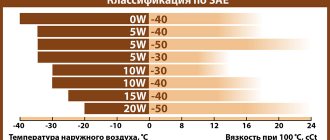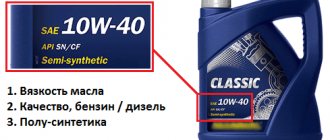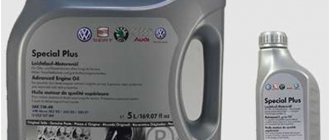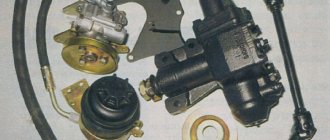The holiday season is approaching, and most auto forums are busy deciding which engine oil to use in the summer - synthetic or semi-synthetic. The issue of choice is aggravated by the similarity of the markings 5w40 from 10w40. Today we will try to answer the question - which engine oil is thicker, 5w40 or 10w 40?
First, a simple option is offered: look in the service book and find out what the manufacturers who developed the car’s power unit write. But the distrust of car enthusiasts is amazing, and we will try to explain what the difference is.
It is clear that the 5w40 brand is clearly synthetic motor oil from most manufacturers. Unlike purely synthetic 5w30 oil, some of the lubricants presented are classified as synthetic, and a number of domestic manufacturers indicate them as semi-synthetic. This is indicated by letters and numbers in large font - European classification according to SAE, and the main characteristics are located according to API. The inscription on the package says the same thing, but in small print.
Classic synthetic 5w40 is considered universal and is recommended for use for many power units. Unlike full synthetics, it is thick and performs well at temperatures down to -35C.
What is hidden behind the motor oil markings?
First, let's look at the two-digit markings that are located on each canister of motor oil. This is the standard SAE marking, which is recognized by the vast majority of manufacturers around the world. In our case, oils 5W-40 and 10W-40 according to SAE - both compositions are all-season, they are prepared for operation at 100ºC engine heating and in the cold. Now a little more detail:
- The first digit (0, 5, 10, etc.) with W is responsible for winter viscosity, i.e. beyond the solidification threshold of the composition at the negative temperature for which the oil is designed. Marker W (from the English winter - winter) means that the oil is designed to work under cold start conditions, when the car, for example, spent the night in the cold and the engine has to be started cold. The higher the value, the more viscous the composition is, which means it flows worse when it gets cold and lubricates the moving parts of the engine worse, the oil filter has a harder time letting it through, etc. This indicator does not affect the operation of a heated system.
| For winter, the best prepared compositions are those marked 0W-40 (-40ºС), 5W-40 (-35ºС) and 10W-40 (-30ºС). |
- The second digit after the hyphen (20, 30, 40, etc.) is responsible for the viscosity at 100 ºC engine operation. The higher the temperature inside the engine, and the more the car heats up in the sun, the more liquid the oil becomes, and this is fraught with deterioration in performance, carbon deposits and leaks. Accordingly, the higher the value, the thicker the composition will be in the summer and with increased heating of the engine.
| 5W-40 and 10W-40 flow without problems in heat up to +40ºС |
The SAE marking is very conditional, and it is not always possible to determine only by it whether an oil is suitable for certain temperature conditions or not - here sometimes a more “subtle” approach to selection is required and selection according to other characteristics: API, ACEA, oil type and characteristics in the data sheet. But the main selection criterion is the manufacturer’s recommendation, which is indicated in the vehicle’s operating instructions.
Features during operation.
You should adhere to the basic rules for changing motor oils:
- try to avoid frequent changes of manufacturers - products from different brands differ significantly in composition and quality;
- when 5w40 oil is partially used up, it can be topped up with 10w40 oil, only produced by the same brand. Otherwise, there is a danger of disruption of the interaction of additives;
- You can mix oils of these two brands when topping up, but only as a temporary measure, since prolonged use of such a mixture results in increased wear of parts.
Engines that convert the energy of burning fuel into mechanical energy (ICE) operate, as a rule, in two liquid environments. This is external (water jacket) cooling, heat removal, and its uniform distribution occurs due to the forced circulation of coolant.
The second liquid medium that ensures normal engine operation during long-term operation is the lubrication of rubbing surfaces using engine oil moving inside the engine under pressure from an oil pump.
The performance, efficiency and durability of the engine under various operating conditions largely depend on the quality of the engine oil and its manufacturing method.
What is better in terms of viscosity in winter - 5W-40 or 10W-40?
Based on the previous point, we found out that the difference between oils lies in their viscosity. Accordingly, 5W-40 and 10W-40 are distinguished by their fluidity in cold temperatures; their endurance at 100ºC when the engine warms up is almost identical.
| Why practically? Each composition has unique data on pour point, flash point, kinematic viscosity, etc., which can only be found by referring to its data sheet. |
5W-40 motor oil is better prepared for working in cold weather, although the “hot” data for both compositions are identical. In winter it can be used down to -35 ºС - at this temperature the manufacturer guarantees uninterrupted operation of the crankshaft and oil pump. The starter is guaranteed to start the engine at a temperature of -30ºС. This is the most universal oil, which is most often used by car enthusiasts in the middle zone. The 10W-40 composition has much less endurance at negative air temperatures. Oils with index 10W-40 lubricate and facilitate the operation of the crankshaft at temperatures down to -30ºС and the starter at -25ºС.
| Limit yield for crankshaft operation | |
| SAE Index | Threshold of stable operation |
| 0W | -40ºС |
| 5W | -35ºС |
| 10W | -30ºС |
| Limit fluidity for engine starting | |
| SAE Index | Threshold of stable operation |
| 0W | -35ºС |
| 5W | -30ºС |
| 10W | -25ºС |
Accordingly, you need to choose the ideal composition according to the climatic conditions in which the car will be used all year round. For cold climates, 5W-40 oil is suitable - it will ensure high-quality and safe operation at temperatures from +35ºС to -35ºС, this way you will slightly reduce fuel consumption and make it easier for the engine to operate during cold starts. For less severe conditions, use 10W-40, because it crystallizes already at a temperature of -25 ºС. However, due to its viscosity, it has a couple of advantages in conditions of heavy loads on the engine in the summer.
| It is also not worth taking oil with too high a viscosity - a protective film that is too thick conducts heat less well, which means the engine will overheat. Too liquid a composition will only lead to leaks and waste. The result is obvious - the same extra fuel consumption and wear and tear. |
Again, let’s make a reservation that these are very average values - real data should be looked at in the technical data sheet that each train has. Look for data on the manufacturer's official website. But all this is just a theory. Each type of engine has its own needs and, accordingly, recommended motor oils. It is more correct to select a lubricant composition based not on theoretical concepts, but primarily on the recommendations of the car manufacturer. All tolerances are specified in the machine operating instructions. And only if the manufacturer allows you to fill in both 5W-40 and 10W-40, choose according to your needs.
10w40 - main indicators
Many automakers classify 10w40 as semi-synthetic. The main difference is in the degree of purification and, in addition, in additional additives, since the base for any lubrication is a mineral additive. Chemists are working on it, except for the latest generation of synthetic fluids. This engine oil is designated by numbers.
The unit starts easily in winter at -25C, in summer it behaves similarly to 5w40. In summer, both oils have identical viscosity; they have no other advantages relative to each other, except for the additives used from the manufacturers.
What kind of oil should I put in an old engine?
If the manufacturer recommends pouring both types of oil into the engine, then the question arises: what viscosity is suitable for a car with, for example, 100,000 km, which is already beginning to wear out? Since engine parts become loose over time and the gaps in them widen, to prevent leaks and carbon deposits, take compounds with a higher viscosity. Thick oil will form a wide protective layer, which will help the old engine do its job much longer and not burn out or leak.
| Since the 10W-40 composition is more viscous, it should be used in a used car. |
The main thing here is not to overdo it. After all, a more viscous composition puts more stress on the crankshaft and other parts. Before deciding to change the oil to a more viscous one, check the vehicle's operating instructions.
Results
It’s good when the car’s engine system works properly and efficiently, but for this it is necessary to answer the question: “What is the difference between 5w40 oil and 10w 40?” and “which oil is thicker 5w40 or 10w 40.” Each brand of vehicle has its own motor fluid capable of restoring and maintaining high performance properties. And it can only be determined with the help of the car manufacturer. Having figured out the difference between 10w40 and 5w40, do not rush to pour them under the hood of the vehicle, but first read the requirements of its operating manual. If it states that the use of a specific viscosity is prohibited, do not neglect this rule. Perhaps it will save you from expensive car repairs.
Is it possible to mix motor oils?
You can mix formulations of different viscosities, but only if there is simply no other choice. For example, if a deficiency is discovered, but the trip cannot be postponed. Then it is possible to add, for example, a little 10W-40 to the 5W-40, so that the engine does not run dry - and this is the worst thing.
| In general, there is no categorical prohibition on mixing two compounds - the additive packages for synthetic and semi-synthetic compounds are approximately the same. |
What you definitely shouldn’t do is mix oils of different base types - for example, a mineral composition with a synthetic one. In theory, synthetics and synthetics from the same manufacturer can be mixed and this will definitely not cause serious problems. In addition, all oils undergo the same compatibility tests, and if its composition does not pass, it simply will not be given a certificate and will not be assigned an API index. The problem here is that manufacturers keep the exact data on the composition of oils secret, this is a company secret and nothing can be done about it. Therefore, it is quite difficult to accurately predict what will happen to the engine if oils with different data are mixed in it. In an engine, oils with different viscosities will inevitably enter into a chemical reaction with each other, but how this will end is a field for experimentation, but would you want to experiment with your own engine? This certainly won’t kill it, but long-term use of a mixed composition will inevitably make itself felt by increased consumption, carbon deposits or an increased degree of wear. Therefore, at the first opportunity, you should go to a car service center, completely drain the old fluid from the car, change the oil filter and fill in new, clean oil.
| Remember that you can only mix oils from the same manufacturer. This way you can at least be sure that there will be liquids with a similar composition inside the engine. |
But what about the transition from one oil to another?
Knowledgeable drivers will immediately object that the oil in the engine cannot be completely “clean”, and in any case the liquids are mixed during the seasonal oil change. And they will be right. This is especially true for those who are going to fill a car with a different type of composition - synthetics instead of mineral water, for example. Or when moving to another region where a composition with different properties is required.
| For cold temperatures, it is possible to slightly reduce the value after W, i.e. take 30 in place of 40. This way you will slightly reduce fuel consumption while the engine warms up. The same should be done for urban conditions. |
Indeed, no matter how thoroughly the engine is drained and cleaned with flushing oils, 3-5% of the lubricating fluid will still remain on the cylinder walls and in the most inaccessible corners. This means that mixing of oils, even in small volumes, will definitely happen, and it’s hardly possible to do anything about it, and it’s not really necessary. The main thing is to follow the oil change schedule and do not let the car run on an old composition with a spent resource. Then mixing the waste residues with the new lubricating fluid will definitely be harmless, even if you did not use flushing.
| In any case, it is better to use oils from one manufacturer: this way you will reduce the risk of a reaction with unpredictable consequences. For example, if you drove with Shell brand oil with a viscosity of 10W-40, then fill in 5W-40 oil from the same Shell and safely start the engine. |









